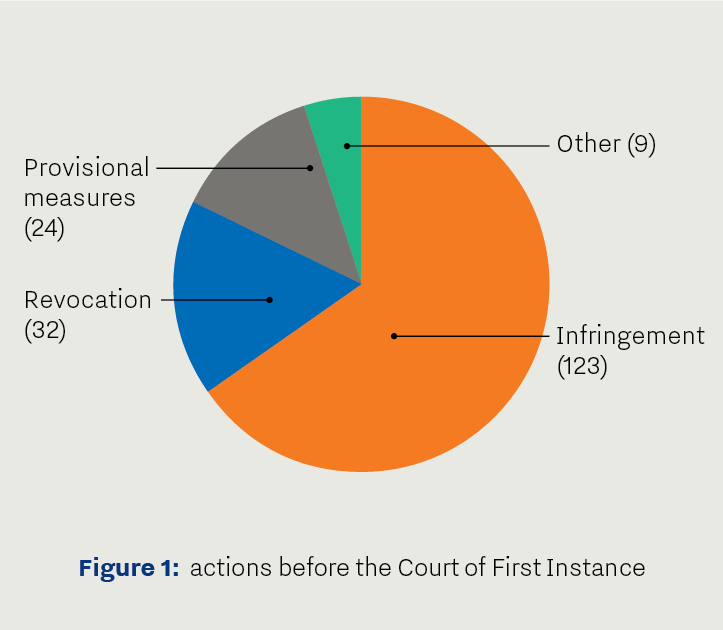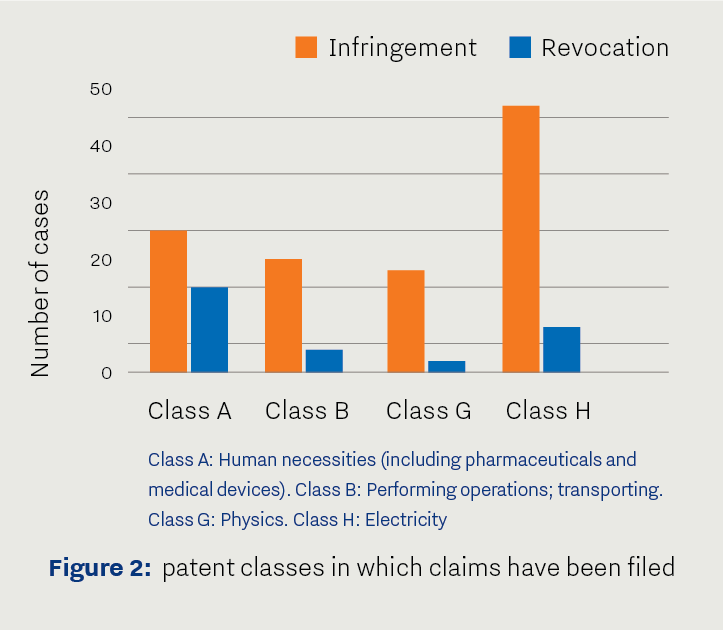Current affairs

The UPC is one year old
The Unified Patent Court (UPC) is a new European court specialized in patent litigation. It currently has jurisdiction in 17 European countries and Romania will join as the 18th country by 1 September 2024. Its start on 1 June 2023 marks a milestone in the European IP landscape. What can be learned from the first year of the UPC?
The numbers
From its start to the end of April 2024, the UPC has received 341 cases, of which 123 cases are infringement actions. In 54 of these infringement actions, 153 counterclaims for revocation were raised. The number of counterclaims exceeds the number of infringement actions, because separate counterclaims were raised by individual defendants. Further, the court has received 32 (separate) revocation actions and 24 applications for provisional measures (see Fig. 1). Interestingly, most cases were filed in Germany (213 cases). Smaller numbers were filed in The Hague (9) and Brussels (2).
When looking at the topics of disputes, almost 40% of the infringement cases concerned an electrotechnical patent. However, revocation actions were most frequently filed in the field of human necessities (almost 50% of all cases, Fig. 2).
Well-substantiated and valuable
In the first year, the UPC mainly dealt with preliminary injunctions, wherein procedural aspects of the UPC agreement were clarified by the Court. In the process, procedural aspects of the UPC agreement were further clarified. For example, the Court of First Instance accepted a change of language of the proceedings from German to English which was requested by a defendant small and medium-sized enterprise (SME). In its decision, the court specifically addressed the UPC’s aim to ensure fair access to justice, especially for SMEs (UPC_CFI_373/2023).
Further, the first substantive decision of the Court of Appeal offers a sneak peak in how basic terms of the law should be interpreted under the UPC agreement. In NanoString v 10x Genomics, the Court of Appeal held, contrary to the Court of First Instance, that it was “predominantly probable” that the injuncted patent would not be valid. In particular, it was considered “overwhelmingly probable” that the claimed invention would lack inventive step. Notably, in the assessment of inventive step, the Court did not expressly use the EPO’s structural “problem-and-solution” approach.
Both first instance and appeal decisions are well-substantiated and offer valuable insights in the UPC. This view is confirmed by our own experience when attending UPC hearings, where both legally and technically qualified judges have proven their broad expertise.
First impression is positive
The start of the UPC can be considered a success. The first substantive decisions of both Court of First Instance and Court of Appeal made a solid impression and the Courts seem to meet their strict deadlines. We look forward to assisting parties before the new European court and thus contributing to the further development of the legal system.
Figure 1 shows actions before the Court of First Instance
Figure 2 shows patent classes in which claims have been filed |


Share
Poll
Wat gaat het nieuwe octrooisysteem (UPC) voor mij betekenen?
Als het UPC en unitair octrooi worden ingevoerd, zal ik:
voor mijn bestaande en nieuwe EU octrooien waarschijnlijk kiezen voor UPC
25%
voorlopig nog het huidige systeem volgen en eerst de UPC-ontwikkelingen afwachten
25%
niet weten wat het beste is om te doen
25%
Kies uw antwoord en zie de reacties van andere lezers!
Lees meer over het UPC en het unitair octrooi.